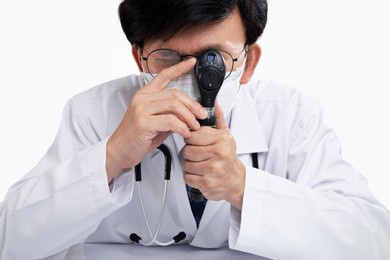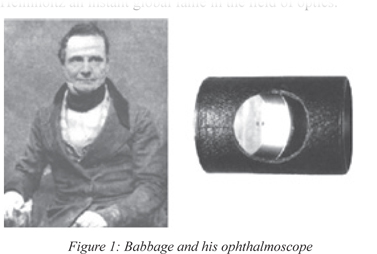
The direct ophthalmoscope is an extremely important examination tool not only for ophthalmologists but for physicians as well. It is probably the only tool in ophthalmology that can help perform a complete ocular examination. This article highlights the development, functioning and use of direct ophthalmoscopes.
A peak in the past
Scientists had tried to peer into the then unknown back of the eye in the 18th and 19th century but were unsuccessful in understanding and establishing a coaxial illumination observation system. Then in the mid 19th century, several scientists noticed that if they kept a light source (pointed at the subject) very near their eye, then in some cases (emmetropes) they could view the red reflex and retina. It was in 1849 that Charles Babbage made what was probably the first practical ophthalmoscope.[1] (Figure 1). It was a simple piece of mirror with a silver patch rubbed off from the centre to make it see-through. Shortly afterwards, in 1851, Hermann Von Helmholtz published a monograph describing in detail the optical working of an ophthalmoscope and a designed a practical ophthalmoscope very similar to the ones used today.(Figure 2) Helmholtz is recognized as the inventor of the direct ophthalmoscope. An anecdote in this regard is that when Helmholtz tried to interest the king’s physician in his newly invented ophthalmoscope, he was told that it had no value as every known disease of the eye could already be diagnosed without it. Around the same time, the ophthalmoscope gave Helmholtz an instant global fame in the field of optics.
The why, what and how of direct ophthalmoscopy?
Why?
Why direct? It is a direct ophthalmoscope as the image forms directly on the retina and there is no intermediate image akin to that seen in an indirect ophthalmoscope.
Why ophthalmoscope? It is indeed interesting to wonder why this instrument came to be called as an ophthalmoscope since the term ophthalmology was coined a good deal after the invention of the ophthalmoscope by Helmholtz in 1851. It is quite clearly argued in essays written in the nineteenth century that instruments and developing technology such as ophthalmoscope and laryngoscopes actually led to the development of the respective specializations. Of course eye as a clinical science existed well before the development of the ophthalmoscope as is exemplified by the founding of Moorfields eye hospital in 1804 and many others.
Source: puttop.top
The copyright of this article belongs to the originator and does not represent the position of this site. We reprint this article for the purpose of spreading more information, if related to copyright issues please contact delete.
© 2022 By YUSHI - All rights reserved.